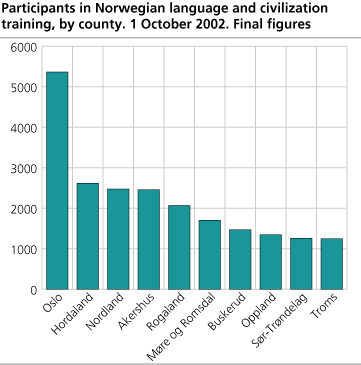Content
Published:
30 000 received Norwegian language and civilization training
By autumn 2002 more than 30 000 adult immigrants participated in Norwegian language and civilization training.
Norwegian language and civilization training is an introductory course which the municipalities are responsible for, although not obligated to, providing adult immigrants. Immigrants are selected for A-level or B-level according to their education from country of origin. Participants who have primary or secondary education from country of origin are selected at the A-level, which is up to 850 lessons. Participants who have less than primary or secondary education from country of origin are selected for B-level, which is up to 3 000 lessons.
By October 1, there were approximately 16 700, or 55 per cent who received level-A training, whereas approximately 13 700, or 45 per cent, received level-B training. Women were in majority, counting 15 861 participants, while there were 14 572 male participants.
10 000 adults received primary and lower secondary education or special education
According to the Education Act, from 1 October 2002 and onwards, all adults who have a need also have the right to receive primary and lower secondary education. The municipalities have the duty to provide such education. By 1 October, almost 3 700 persons received this kind of education, 57 per cent were female and 43 per cent were male.
Adults who are unable to benefit from ordinary educational provisions, or have special needs, have the right to special education. By autumn 2002, more than 7 000 adults, 54 per cent men and 46 per cent women, received special education.
Tables:
Contact
-
Statistics Norway's Information Centre
E-mail: informasjon@ssb.no
tel.: (+47) 21 09 46 42

